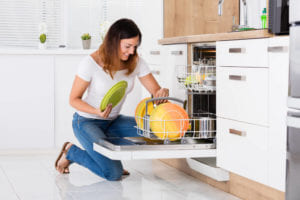Choosing The Best Mixer For Your House
Mixers are not typically needed on a daily basis in the kitchen, but when a recipe calls for some well-mixed ingredients, you can be sure you’ll sorely miss having a good one around. Mixers are fundamental home appliances that come in many shapes, sizes, and categories: they can be large enough to knead bread for a family pizza or versatile enough to prepare batters and purees.
This article assembles our top six favorite mixers in the market today and compares them by size, category, capacity, and more. We’ve also broken down what you need to know about buying a mixer to help you discover which one of these products is truly the best for your home.
Top 6 Best Mixers
- Comes in 10 colors and up to 15 attachments available
- High wattage and weight make this product very stable & powerful
- 67-point planetary action makes mixing super effective
- Comes with a 1-year warranty
- Multi-functionality makes this appliance a must-have for space-saving solutions
- High wattage can mix, blend, and knead effectively
- Lots of attachments available and for a reasonable price
- Includes a 6-month warranty
- Open top design allows cooks to add in ingredient while the food is being mixed
- Very effective for kneading dough with dedicated settings
- Variable speed controls and a timer knob aids in precision mixing
- Comes with a 5-year warranty
- Advanced load sensing technology helps to preserve the lifespan of the appliance
- Unique scraper beater accessory cleans the bowl while mixing food
- High capacity means mixing more food faster
- Includes a 1-year warranty
- 12-speed control offers greater control over the end product
- Included splash guard allows for fast mixing with none of the mess
- Included steel hook is especially handy for kneading dough
- Comes with a 2-year warranty
- 59-point planetary action is one of the highest in this category
- Sturdy and built for attachments to extend use
- Pouring shield allows you to add food without having it flung back at you
- Includes a 1-year warranty

The KitchenAid Professional 600 Series mixer is from a tried and true brand and showcases some of the best features out of any of our product picks. As a bowl-lift mixer, this appliance is designed to fit large amounts of food and make quick work of whatever is put within it.
We really appreciate the strength and consistency of the mixing with this product, and it’s no wonder that KitchenAid has garnered a reputation for success with this line. The cost, however, is certainly reflective of the reputation as well. If you don’t mind the quirks of a bowl lift design or the cost of the product or any attachments, then this may be the most reliable choice for you.
Pros
- Great planetary action
- High wattage
- Lots of attachments available
- Very customizable
- High capacity
Cons
- Expensive
- Can be hard to clean

Posing a stark contrast to the quality and weight of the KitchenAid 600 Professional Series, this all-in-one Comfee 7-in-1 BM2095 aims to offer mixing capabilities at an introductory cost. This mixer comes with room for a blender, food processor, mincer, and more. Of course, these options are sold separately.
Taking a close look at the mixer specifically, Comfee’s focus on versatility seems to have paid off. Seven speeds help cooks get to the consistency and texture they’re looking for out of their food. And while the overall capacity of this Comfee appliance is somewhat lacking, it’s a miracle this product works as well as it does considering the price. For space-conservationists and budget-seekers, this is the unit for you.
Pros
- Highly versatile
- Affordable
- Can be converted to blend
- Small footprint
Cons
- Very light
- Build quality is mediocre
- Capacity is low
The Ankarsrum AKM 6220 is the only on our list to offer an open top mixer, which is a useful and versatile – yet incredibly rare – mixer category. This model allows you to watch and adjust the food as it’s being mixed more so than any other category. The unique top-down but open top design makes for easy maintenance and cleaning, and in some cases, you can lightly blend products with this design as well.
The variable speed means that there’s an almost infinite amount of control over mixing speeds, which is perfect for anyone looking for the perfect consistency. This product is by far the most expensive on our list, so getting the perfect mixture certainly comes at a cost. Overall, we think those who need a dedicated mixer that’s easy to use may want to avoid this model. But for commercial cooks and the especially brave, you’ll get far more control out of the Ankarsrum AKM 6220 than most other offerings.
Pros
- Unique and effective design
- Variable speed
- Easy timer functionality
- Easy to clean
- Sturdy build
Cons
- Expensive
- High learning curve
- Capacity could be larger
Seemingly in competition with KitchenAid’s mixers, the Breville BEM800XL uses special attachments and extra features to set itself apart from stiff competition. It also offers a large capacity at 5 quarts and can easily tackle most mixtures with its twelve distinct speed settings. It’s the included accessories, however, with this product that really gets the most praise.
Breville’s unique scraper beater is able to mix more effectively and even partially clean the inside of the bowl itself. The design sets Breville apart from KitchenAid’s similar tilt head models, alongside weight sensors that help ensure the appliance is only working when it needs to. While we would have preferred a more sturdy design and a lower price, Breville still manages to pull out one of the best tilt head products on our list.
Pros
- Unique accessories
- High capacity
- Great planetary motion
- Handy sensors and timers
- Easy lift head
Cons
- A little expensive
- Build quality is lacking
- Could be more balanced
Trying to find its place between the affordable and light Comfee mixer and the big and bulky KitchenAid product is the Oster Planetary Stand Mixer. This model is a mid-range product at a mid-range price. Included are 12 speeds for greater control of the mix, and a splash guard to allow you to set the speed at whatever you’d like with little repercussions to your countertops. We’re especially big fans of the stainless steel dough hook, which seems to be one of the primary selling points of the appliance.
At 350 watts, this is the least powerful mixer on our list, and while the speeds offered are great, torque and consistency are somewhat lacking. If an efficient and effective dough kneader is something you’ve been after for quite some time, then Oster may have made this mixer especially for you.
Pros
- Great for kneading dough
- Lots of speed settings
- Small footprint
- Great planetary motion
- Easy to clean
Cons
- Low power
- Consistency is somewhat lacking
- Could be heavier
Our final mixer is the KitchenAid Artisan Series, a lift head variant of the 600 Professional Series mixer that opened our list. This mixer is, much like the bowl lift variant, designed to be both a powerfully dedicated mixer as well as a hub for other attachments that can be purchased through the KitchenAid website. Differentiating it from the Professional Series is the included pouring shield, and a reduced weight, capacity, and wattage.
You’ll definitely be getting the quality KitchenAid is known for at a reduced price by going with this model. You’ll also be spending less time on cleaning due to the design and included attachments. Apparently, this model suffers from the same issues most KitchenAid mixers do, including a retro design that may be too bulky for some. though, including a retro design that may be too bulky for some. If you liked the look of the KitchenAid 600 Professional Series but wanted a head lift variant, then the Artisan Series is ideal.
Pros
- Sturdy and consistent
- Cleans easily
- Very powerful
- Lots of attachments available
- Great planetary action
- Very customizable
Cons
- Low wattage
- Can be bulky
- Needs a lot of overhead
Buyer’s Guide:
Mixer For Your House
Mixers, whether tilt head, bowl lift, or open top, all have specific metrics and functionality that can make or break their value to a prospective buyer. If you’re a homeowner who isn’t quite sure which of our six picks would be best for your home, consider the following:
Final Thoughts
Ultimately, your mixer needs are going to dictate the type of product you purchase. And while its hard for us to crown just one of these six products as the best overall, there are a few key takeaways we’d like to note.
If you’re hoping for the best mixer and don’t mind the sometimes-frustrating bowl lift design, then we recommend going for the KitchenAid Professional 600 Series, which balances out a great design and high capacity with wattage, strength, and stability. If you’re hoping for a great mixer like the KitchenAid 600 Professional Series but don’t want to deal with the bowl lift design, then the Artisan Series offers a unique spin on the model while still keeping the features you know and love.
For something a little more affordable, the Comfee 7-in-1 offers similar expansion capabilities at a low cost and with a fair amount of wattage to back it up. No matter which product you pick, from the unique Ankarsrum open top model to the formidable KitchenAid models, we hope that you find the mixer that proves itself to be a mainstay in your home for years to come.










